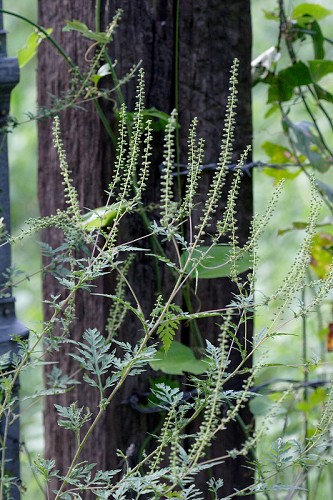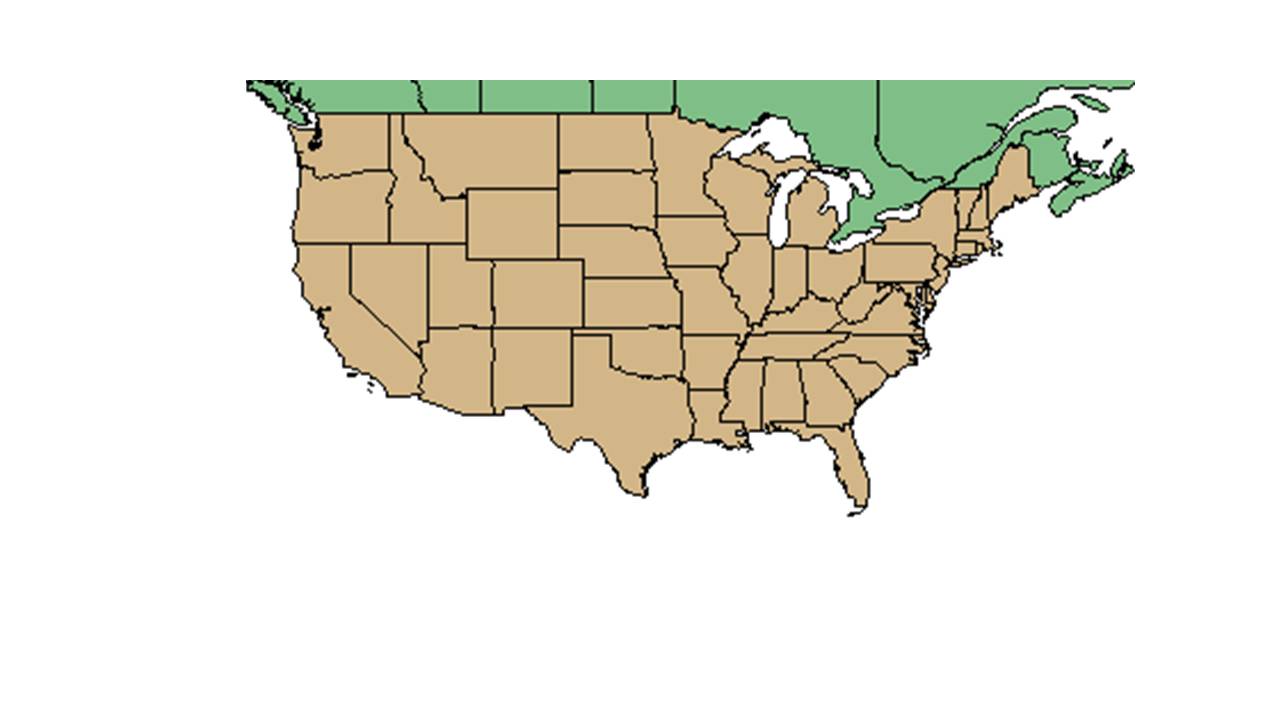Difference between revisions of "Ambrosia artemisiifolia"
KatieMccoy (talk | contribs) (→Distribution) |
|||
| Line 29: | Line 29: | ||
==Distribution== | ==Distribution== | ||
| − | It is common throughout Florida (Wunderlin and Hansen 2003) and throughout the entire United States (Hall 2003). It has been found in open pine woods, mixed hardwoods, wet hammocks, and along dried up shores of ponds | + | It is common throughout Florida (Wunderlin and Hansen 2003) and throughout the entire United States (Hall 2003). It has been found in open pine woods, mixed hardwoods, wet hammocks, and along dried up shores of ponds. It does well in a number of human disturbed areas including old fields, drainage ditches, pastures, roadsides, sandy vacant lots, railroad gravel, blackland prairie soil, camping areas, wet pastures, levees, drainage ditches, along edges of mixed forests, recently disturbed boggy areas, along canals, and agricultural fields. It thrives in dry sandy soils to wet, peaty soils in high intensity light in open areas<ref name="fsu">Florida State University Robert K. Godfrey Herbarium database. URL: http://herbarium.bio.fsu.edu. Last accessed: June 2014. Collectors: Loran C. Anderson, Tom Barnes, R. Barbezat, Sarah Beem, S. Bennett, Kurt E. Blum, Michael B. Brooks, R. C. Darby, Frank DiCecco, William B. Fox, Mary A. Garland, Robert K. Godfrey, Bruce Hansen, G. G. Hedgcock, Norlan C. Henderson, Brenda Herrig, C. Jackson, T. Kanno, Robert Kral, Gary R. Knight, Elmo Law, Martha Lee, S. W. Leonard, S. J. Lombardo, C. L. Lundell, Travis MacClendon, Karen MacClendon, Sidney McDaniel, Richard S. Mitchell, J. B. Morrill, John B. Nelson, R. A. Norris, H. Okazaki, Dan Pittillo, A. E. Radford, Lloyd H. Shinners, Cecil R. Slaughter, Bill Stangler, William R. Stimson, Amanda R. Travis, Charles S. Wallis, Keenan Windler, and Wendy Zomlefer. States and Counties: Alabama: Baldwin. Colorado: Jefferson. Florida: Brevard, Columbia, Dade, Escambia, Franklin, Indian River, Jackson, Jefferson, Leon, Liberty, Okaloosa, Pasco, Polk, Putnam, and Wakulla. Georgia: Colquitt, Decatur, Fulton, Grady, and Thomas. Illinois: Coles, Cook, and Lawrence. Iowa: Fremont. Louisiana: Ouachita. Kansas: Riley. Maryland: Baltimore. Mississippi: Harrison and Oktibbeha. Missouri: Cass, Greene, and Ray. North Carolina: Ashe, Chowan, Macon, Madison, and Wayne. Oklahoma: Ottawa. Pennsylvania: Huntingdon. South Carolina: Dorchester, Lexington, and Richland. Tennessee: Grundy and Polk. Texas: Dallas. Virginia: Giles, Montgomery, and Van Zandt. Other countries: Japan.</ref>. |
==Ecology== | ==Ecology== | ||
Revision as of 13:41, 29 March 2016
| Ambrosia artemisiifolia | |
|---|---|

| |
| Photo by John R. Gwaltney Southeastern Flora.com | |
| Scientific classification | |
| Kingdom: | Plantae |
| Division: | Magnoliophyta - Flowering plants |
| Class: | Magnoliopsida – Dicotyledons |
| Order: | Asterales |
| Family: | Asteraceae ⁄ Compositae |
| Genus: | Ambrosia |
| Species: | A. artemisiifolia |
| Binomial name | |
| Ambrosia artemisiifolia L. | |

| |
| Natural range of Ambrosia artemisiifolia from USDA NRCS Plants Database. | |
Common names: Common Ragweed
Contents
Taxonomic notes
Synonyms: A. artemisiifolia Linnaeus var. elatior (Linnaeus) Descourtils; A. artemisiifolia Linnaeus var. paniculata (Michaux) Blank; A. artemisiifolia Linnaeus var. artemisiifolia; A. elatior Linnaeus; A. monophylla (Walter) Rydberg; A. glandulosa Scheele
Description
Annual. Are rhizomatous, perennial herb with pubescent stems and usually freely branched. The leaves are opposite, the upper are alternate, linear, 1-4.5cm long, 0.5-3mm wide, entire, the base are attenuate, and pubescent on both surfaces. The petioles are obscured by decurrent blade tissues. The racemes are 3-20cm long. The involucres are 1.5-3mm long. The nutlets are black in color, are pubescent at the apex, obovoid in shape, turgid, and 1.6-2.1mm long. Flowers September to October. (Radford 1964).
Annual. Grows 0.2-2m tall, with a taproot. Has freely branched stems. The leaves are deeply bipinnately dissected with acute sinuses, the lower are opposite, the upper are alternate, 5-15cm long. The segments are mostly less than 1cm wide and are acute. The pistillate involucres are fascicled in upper leaf axils, obovoid in shape, pubescent to glabrate, 2.5-3.5mm long, 1.5-2.5mm in diameter, angulate, each with 5-6 rarely fewer, erect projections toward the apex. The staminate heads are 2-4mm broad, irregularly more or less 5-lobed, peduncles 1-6mm long. The nutlets are brown in color and 3-3.5mm long. Flowers August to frost. (Radford 1964).
Distribution
It is common throughout Florida (Wunderlin and Hansen 2003) and throughout the entire United States (Hall 2003). It has been found in open pine woods, mixed hardwoods, wet hammocks, and along dried up shores of ponds. It does well in a number of human disturbed areas including old fields, drainage ditches, pastures, roadsides, sandy vacant lots, railroad gravel, blackland prairie soil, camping areas, wet pastures, levees, drainage ditches, along edges of mixed forests, recently disturbed boggy areas, along canals, and agricultural fields. It thrives in dry sandy soils to wet, peaty soils in high intensity light in open areas[1].
Ecology
Habitat
It is found in disturbed sites (Wunderlin and Hansen 2003).
Associated species include Agalinis divaricata, pine, hickory; Euphorbia, Andropogon, Bidens, Paspalum urvillei, P. notatum, Eragrostis oxylepis, Eleusine indica, Digitaria sanguinalis, Cyperus surinamensis, Ambrosia artemisifolia, Strophostyles helvola, Solanum americanum, S. sisymbriifolium, Daubentonia drummondii, Sesbania exaltata, cabbage palmetto, Emilia fosbergii, Paspalum setaceum, Heterotheca subaxillaris, Boerhavia diffusa, Bothriochloa ischaemum; Croton capitatus and various grasses (FSU Herbarium).
Phenology
It flowers and fruits from summer to late fall (Wunderlin and Hansen 2003, FSU Herbarium).
Fire ecology
It can live where winter-burned annually and has been found in firelanes of annually-burned pinelands (FSU Herbarium).
Conservation and Management
Cultivation and restoration
Photo Gallery
References and notes
Florida State University Robert K. Godfrey Herbarium database. URL: http://herbarium.bio.fsu.edu. Last accessed: June 2014. Collectors: Loran C. Anderson, Tom Barnes, R. Barbezat, Sarah Beem, S. Bennett, Kurt E. Blum, Michael B. Brooks, R. C. Darby, Frank DiCecco, William B. Fox, Mary A. Garland, Robert K. Godfrey, Bruce Hansen, G. G. Hedgcock, Norlan C. Henderson, Brenda Herrig, C. Jackson, T. Kanno, Robert Kral, Gary R. Knight, Elmo Law, Martha Lee, S. W. Leonard, S. J. Lombardo, C. L. Lundell, Travis MacClendon, Karen MacClendon, Sidney McDaniel, Richard S. Mitchell, J. B. Morrill, John B. Nelson, R. A. Norris, H. Okazaki, Dan Pittillo, A. E. Radford, Lloyd H. Shinners, Cecil R. Slaughter, Bill Stangler, William R. Stimson, Amanda R. Travis, Charles S. Wallis, Keenan Windler, and Wendy Zomlefer. States and Counties: Alabama: Baldwin. Colorado: Jefferson. Florida: Brevard, Columbia, Dade, Escambia, Franklin, Indian River, Jackson, Jefferson, Leon, Liberty, Okaloosa, Pasco, Polk, Putnam, and Wakulla. Georgia: Colquitt, Decatur, Fulton, Grady, and Thomas. Illinois: Coles, Cook, and Lawrence. Iowa: Fremont. Louisiana: Ouachita. Kansas: Riley. Maryland: Baltimore. Mississippi: Harrison and Oktibbeha. Missouri: Cass, Greene, and Ray. North Carolina: Ashe, Chowan, Macon, Madison, and Wayne. Oklahoma: Ottawa. Pennsylvania: Huntingdon. South Carolina: Dorchester, Lexington, and Richland. Tennessee: Grundy and Polk. Texas: Dallas. Virginia: Giles, Montgomery, and Van Zandt. Other countries: Japan.
Hall, David W. Illustrated Plants of Florida and the Coastal Plain: based on the collections of Leland and Lucy Baltzell. 1993. A Maupin House Book. Gainesville. 74. Print.
Radford, Albert E., Harry E. Ahles, and C. Ritchie Bell. Manual of the Vascular Flora of the Carolinas. 1964, 1968. The University of North Carolina Press. 1016-1018. Print.
Wunderlin, Richard P. and Bruce F. Hansen. Guide to the Vascular Plants of Florida. Second edition. 2003. University Press of Florida: Gainesville/Tallahassee/Tampa/Boca Raton/Pensacola/Orlando/Miami/Jacksonville/Ft. Myers. 296. Print.
- ↑ Florida State University Robert K. Godfrey Herbarium database. URL: http://herbarium.bio.fsu.edu. Last accessed: June 2014. Collectors: Loran C. Anderson, Tom Barnes, R. Barbezat, Sarah Beem, S. Bennett, Kurt E. Blum, Michael B. Brooks, R. C. Darby, Frank DiCecco, William B. Fox, Mary A. Garland, Robert K. Godfrey, Bruce Hansen, G. G. Hedgcock, Norlan C. Henderson, Brenda Herrig, C. Jackson, T. Kanno, Robert Kral, Gary R. Knight, Elmo Law, Martha Lee, S. W. Leonard, S. J. Lombardo, C. L. Lundell, Travis MacClendon, Karen MacClendon, Sidney McDaniel, Richard S. Mitchell, J. B. Morrill, John B. Nelson, R. A. Norris, H. Okazaki, Dan Pittillo, A. E. Radford, Lloyd H. Shinners, Cecil R. Slaughter, Bill Stangler, William R. Stimson, Amanda R. Travis, Charles S. Wallis, Keenan Windler, and Wendy Zomlefer. States and Counties: Alabama: Baldwin. Colorado: Jefferson. Florida: Brevard, Columbia, Dade, Escambia, Franklin, Indian River, Jackson, Jefferson, Leon, Liberty, Okaloosa, Pasco, Polk, Putnam, and Wakulla. Georgia: Colquitt, Decatur, Fulton, Grady, and Thomas. Illinois: Coles, Cook, and Lawrence. Iowa: Fremont. Louisiana: Ouachita. Kansas: Riley. Maryland: Baltimore. Mississippi: Harrison and Oktibbeha. Missouri: Cass, Greene, and Ray. North Carolina: Ashe, Chowan, Macon, Madison, and Wayne. Oklahoma: Ottawa. Pennsylvania: Huntingdon. South Carolina: Dorchester, Lexington, and Richland. Tennessee: Grundy and Polk. Texas: Dallas. Virginia: Giles, Montgomery, and Van Zandt. Other countries: Japan.